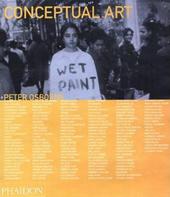
|
Conceptual Art
Hardback
Main Details
| Title |
Conceptual Art
|
| Authors and Contributors |
Translated by Nathalie Chapuis
|
|
Designed by Roger Fawcett-Tang
|
|
By (author) Mr Tony Godfrey
|
| Physical Properties |
| Format:Hardback | | Pages:304 | | Dimensions(mm): Height 290,Width 250 |
|
| Category/Genre | Art and design styles - Conceptual art |
|---|
| ISBN/Barcode |
9780714839301
|
| Classifications | Dewey:709.04075 |
|---|
| Audience | | General | | Postgraduate, Research & Scholarly | | Undergraduate | |
|---|
|
Publishing Details |
| Publisher |
Phaidon Press Ltd
|
| Imprint |
Phaidon Press Ltd
|
| Publication Date |
28 June 2002 |
| Publication Country |
United Kingdom
|
Description
This text marks an original and authoritative re-examination of a major turining point in late 20th-century art. Since the mid 1960s conceptual art - an art that consists of ideas written down, enacted or simply carried in your head - has directly challenged the very notion that a work of art is by definition an object of visual pleasure. Conceptual art is first and foremost an art of questions. As this text demonstrates conceptual art continues today to raise fundamental questions not only about the definition of art itself but about politics, the media and society. This volume brings together all the most recent critical perspectives on conceptual art - such as the inclusion of work produced outside of Europe and the USA, in Japan, South America, China, Russia and Eastern Europe. It also offers a thematic overview of conceptual art which should prove valuable to anyone studying the movement, dividing it into six distinctive categories: six different ways in which artists contested traditional notions of art by highlighting the role of ideas in the production of art's meaning. Section one, "Pre-history, 1940-1960", presents the main precursors of conceptual art in the USA, Europe and Japan. Section two, "Instruction, Performance, Documentation", traces the emergence of the first "conceptual" artworks as the scores of experimental music developed into "scores" or instructions for events and actions. Section three, "Process, System, Series", looks at the kind of conceptual art, linked to minimalism, that explores ideal systems of logical, mathematical and spatial relationships. Section four, "Word and Sign", considers art centred on language in the form of painted, printed or written texts. Section five, "Appropriation, Intervention, Everyday", deals with art that intervenes in other cultural forms or activities in order to transform them - ranging from projects using advertising billboards to activities such as cleaning the streets. Section six, "Politics and Ideology", focuses on art that reflects on and conveys explicity political contents. Section seven, "Institutional Critique", is devoted to works that examine the power structures underlying the institutions of art. Section eight, "Afterwards, 1980-2000", samples key works of the "post-conceptual" installation art that dominates the international art world today. Conceptual art, since its high period from the 1966 to 1972, has not only influenced all subsequent art but has made a major contribution to the history of ideas. Conceptual art in turn drew much of its inspirations from the writings of thinkers ranging from the philosopher Ludwig Wittenstein to the playwright Samuel Beckett. This text presents excerpts from these key influential writings alongside major original texts by artists, critics, curators and art historians in the "Documents" section.
Author Biography
Peter Osborne is Professor of Modern European Philosophy and Tutor on the Graduate Programme in Aesthetics and Art Theory at Middlesex University, London. He is the author of The Politics of Time: Modernity and the Avant-Garde (Verso, 1995) and Philosophy in Cultural Theory (Routledge, 2001). He was a contributor to Rewriting Conceptual Art (eds. Michael Newman; Jon Bird, Reaktion Books, 1999) and has edited and co-edited several critical anthologies including A Critical Sense: Interviews with Intellectuals (Routledge, 1997) and From an Aesthetic Point of View: Philosophy, Art and the Senses (Serpents Tail, 2001). Author's Residence: London
Reviews'authoritative' Christie's Books, Summer 2002 US quotes 'more than just a compilation of sources, documents, and images - Osborne offers an original, challenging, reinterpretation of Conceptual Art - a solid contribution to the burgeoning re-examination of Conceptual Art.' Barry Schwabsky, BookForum, Winter 2002
|